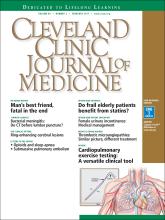Article Figures & Data
Tables
Study Design Population Mean follow-up PROSPER13 Randomized controlled trial
Pravastatin 40 mg vs placeboN = 5,804, mean age 75
Primary and secondary prevention
Mini-Mental State score ≥ 24 of 303.2 years JUPITER28,29 Randomized controlled trial
Rosuvastatin 20 mg vs placeboN = 5,695 (elderly subgroup)
Median age 74
Primary prevention1.9 years (stopped prematurely) CTT32 Meta-analysis Not applicablea Variable Afilalo et al31 Meta-analysis N = 19,569
Age range 65–82
Secondary prevention4.9 years SPARCL27,30 Randomized controlled trial
Atorvastatin 80 mg vs placeboN = 2,249 (subgroup age ≥ 65)
Mean age of subgroup 72.4
Secondary prevention4.9 years GISSI-HF25 Randomized controlled trial
Rosuvastatin 10 mg vs placeboN = 4,574, mean age 68
Heart failure, NYHA class II to IV3.9 years (median) CORONA26 Randomized controlled trial
Rosuvastatin 10 mg vs placeboN = 5,011, mean age 73
Heart failure, NYHA class II to IV2.7 years ↵a The CTT meta-analysis presents the effects of statins on major vascular events per annum, per 1.0 mmol/L reduction in LDL-C according to 5-year risk at baseline. The analysis in patients > 70 years old includes a total of 2,952 events in the statin group and 3,385 events in the control group (or a total of 6,337 events.
CORONA = Controlled Rosuvastatin Multinational Trial in Heart Failure; CTT = Cholesterol Treatment Trialists; GISSI-HF= Gruppo Italiano per lo Studio della Sopravvivenza nell’Insufficienza Cardiaca Heart Failure; JUPITER = Justification for the Use of Statins in Prevention; NYHA = New York Heart Association; PROSPER = Prospective Study of Pravastatin in the Elderly at Risk; SPARCL = Stroke Prevention by Aggressive Reduction in Cholesterol Levels
Trial and outcome Event rate P value Absolute risk reduction Relative risk reduction Number needed to treat (95% CI) Placebo Statin Primary prevention studies PROSPER13
Coronary heart disease death and nonfatal myocardial infarction8.8% 7.9% .401 0.9% 9% NSa JUPITER28,29
yocardial infarction1.1% 0.6% .046 0.5% 45% 211 (106–32,924) Secondary prevention studies PROSPER13
Coronary heart disease death and nonfatal myocardial infarction (includes definite and suspect events)16.8% 12.7% .004 4.1% 24% 25 (15–77) Afilalo et al meta-analysis31
Nonfatal myocardial infarctionNA NA NA NA 26%b 38 (16–118)b Combined primary and secondary prevention studies PROSPER13
Nonfatal myocardial infarction (excluding silent and unrecognized events)4.3% 3.4% .099 0.9% 20% NSa ↵a Not statistically significant (P > .05) and numbers needed to treat (NNT) not calculated on these results. NNT calculated on raw numbers if not provided in publication. See Table 1 for duration of treatment required for NNT.
↵b Afilalo et al provided relative risk reductions and NNTs in their publication. Absolute risk reductions not calculated on meta-analytic outcomes.
CI = confidence interval; NA = not available; NS = not statistically significant
Trial and outcome Event rate P value Absolute risk reduction Relative risk reductiona Number needed to treat (95% CI) Placebo Statin Primary prevention studies PROSPER13
Fatal or nonfatal stroke
Transient ischemic attack3.7% 3.8% .882 0.1% increase 3% increase NSb 2.3% 1.9% .422 0.4% 18% NS JUPITER28,29
Stroke (percent based on raw number of events)1.4% 0.8% .023 0.6% 45% 161 (86–1,192) Secondary prevention studies PROSPER13
Fatal and nonfatal stroke
Transient ischemic attack5.5% 5.7% .838 0.2% increase 3% increase NS 5.1% 3.6% .065 1.5% 29% NS Afilalo meta-analysis31
Stroke (disabling and nondisabling)NA NA NA NA 25% 58c (27–177) SPARCL27
Fatal or nonfatal stroke
Nonfatal stroke13.1% 11.2% .03 1.9% 15% 52 (26–1,303) 11.8% 10.4% .11 1.4% 12% NS SPARCL subgroup ≥ 6530
Fatal or nonfatal stroke16.2% 14.7% .33 1.5% 10% NS SPARCL subgroup < 6530
Fatal or nonfatal stroke10.5% 7.9% .022 2.6% 24% 39 (21–354) ↵a Numbers for relative risk reduction are rounded to the nearest whole number
↵b Not statistically significant (P >.05) and numbers needed to treat not calculated on these results. Number needed to treat (NNT) calculated on raw numbers if not provided in publication. See Table 1 for duration of treatment required for NNT. CI = confidence interval
↵c Afilalo et al provided relative risk reductions and NNT. Absolute risk reductions not calculated on meta-analytic outcomes.






